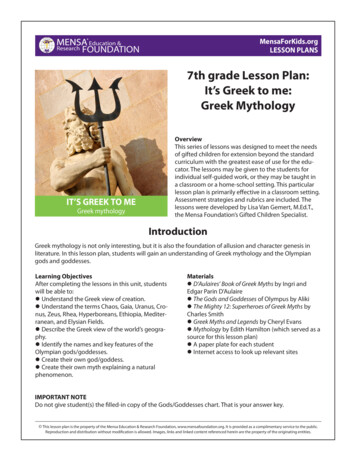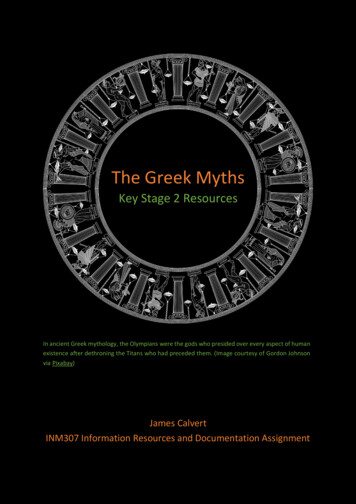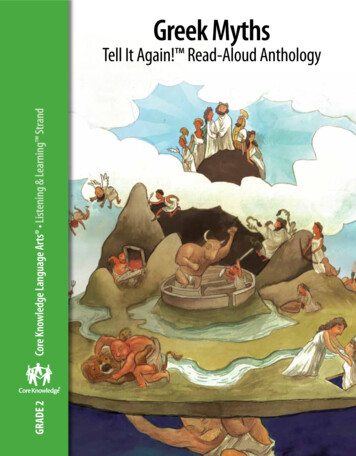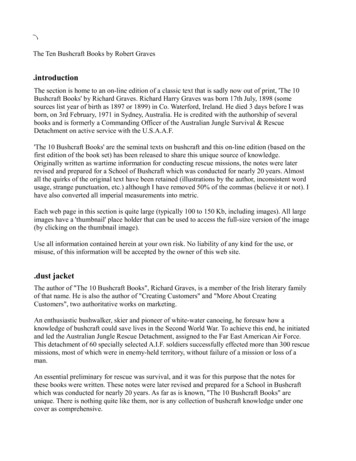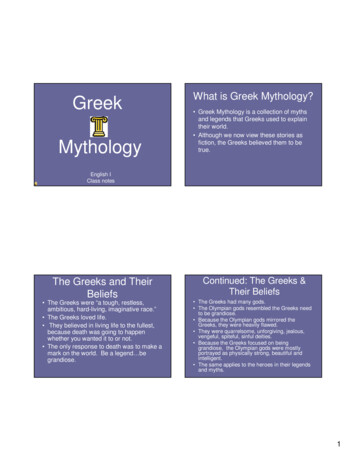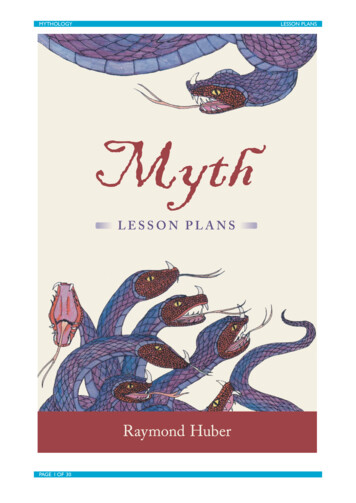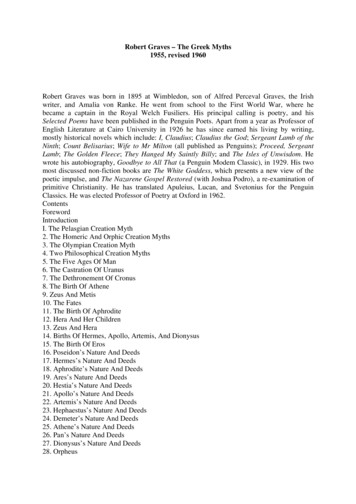
Transcription
Robert Graves – The Greek Myths1955, revised 1960Robert Graves was born in 1895 at Wimbledon, son of Alfred Perceval Graves, the Irishwriter, and Amalia von Ranke. He went from school to the First World War, where hebecame a captain in the Royal Welch Fusiliers. His principal calling is poetry, and hisSelected Poems have been published in the Penguin Poets. Apart from a year as Professor ofEnglish Literature at Cairo University in 1926 he has since earned his living by writing,mostly historical novels which include: I, Claudius; Claudius the God; Sergeant Lamb of theNinth; Count Belisarius; Wife to Mr Milton (all published as Penguins); Proceed, SergeantLamb; The Golden Fleece; They Hanged My Saintly Billy; and The Isles of Unwisdom. Hewrote his autobiography, Goodbye to All That (a Penguin Modem Classic), in 1929. His twomost discussed non-fiction books are The White Goddess, which presents a new view of thepoetic impulse, and The Nazarene Gospel Restored (with Joshua Podro), a re-examination ofprimitive Christianity. He has translated Apuleius, Lucan, and Svetonius for the PenguinClassics. He was elected Professor of Poetry at Oxford in 1962.ContentsForewordIntroductionI. The Pelasgian Creation Myth2. The Homeric And Orphic Creation Myths3. The Olympian Creation Myth4. Two Philosophical Creation Myths5. The Five Ages Of Man6. The Castration Of Uranus7. The Dethronement Of Cronus8. The Birth Of Athene9. Zeus And Metis10. The Fates11. The Birth Of Aphrodite12. Hera And Her Children13. Zeus And Hera14. Births Of Hermes, Apollo, Artemis, And Dionysus15. The Birth Of Eros16. Poseidon’s Nature And Deeds17. Hermes’s Nature And Deeds18. Aphrodite’s Nature And Deeds19. Ares’s Nature And Deeds20. Hestia’s Nature And Deeds21. Apollo’s Nature And Deeds22. Artemis’s Nature And Deeds23. Hephaestus’s Nature And Deeds24. Demeter’s Nature And Deeds25. Athene’s Nature And Deeds26. Pan’s Nature And Deeds27. Dionysus’s Nature And Deeds28. Orpheus
29. Ganymedes30. Zagreus31. The Gods Of The Underworld32. Tyche And Nemesis33. The Children Of The Sea34. The Children Of Echidne35. The Giants’ Revolt36. Typhon37. The Aloids38. Deucalion’s Flood39. Atlas And Prometheus40. Eos41. Orion42. Helius43. The Sons Of Hellen44. Ion45. Alcyone And Ceyx46. Tereus47. Erechtheus And Eumolpus48. Boreas49. Alope50. Asclepius51. The Oracles52. The Alphabet53. The Dactyls54. The Telchines55. The Empusae56. Io57. Phoroneus58. Europe And Cadmus59. Cadmus And Harmonia60. Belus And The Danaids61. Lamia62. Leda63. Ixion64. Endymion65. Pygmalion And Galatea66. Aeacus67. Sisyphus68. Salmoneus And Tyro69. Alcestis70. Athamas71. The Mares of Glaucus72. Melampus73. Perseus74. The Rival Twins75. Bellerophon76. Antiope77. Niobe78. Caenis And Caeneus
79. Erigone80. The Calydonian Boar81. Telamon And Peleus82. Aristaeus83. Midas84. Cleobis And Biton85. Narcissus86. Phyllis And Carya87. Arion88. Minos And His Brothers89. The Loves Of Minos90. The Children Of Pasiphaë91. Scylla And Nisus92. Daedalus And Talos93. Catreus And Althaemenes94. The Sons Of Pandion95. The Birth Of Theseus96. The Labours Of Theseus97. Theseus And Medea98. Theseus In Crete99. The Federalization Of Attica100. Theseus And The Amazons101. Phaedra And Hippolytus102. Lapiths And Centaurs103. Theseus In Tartarus104. The Death Of Theseus105. Oedipus106. The Seven Against Thebes107. The Epigoni108. Tantalus109. Pelops And Oenomaus110. The Children Of Pelops111. Atreus And Thyestes112. Agamemnon And Clytaemnestra113. The Vengeance Of Orestes114. The Trial Of Orestes115. The Pacification Of The Erinnyes116. Iphigeneia Among The Taurians117. The Reign Of Orestes118. The Birth Of Heracles119. The Youth Of Heracles120. The Daughters Of Thespius121. Erginus122. The Madness Of Heracles123. The First Labour: The Nemean Lion124. The Second Labour: The Lernaean Hydra125. The Third Labour: The Ceryneian Hind126. The Fourth Labour: The Eryminthian Boar127. The Fifth Labour: The Stables Of Augeias128. The Sixth Labour: The Stymphalian Birds
129. The Seventh Labour: The Cretan Bull130. The Eighth Labour: The Mares Of Diomedes131. The Ninth Labour: Hippolyte’s Girdle132. The Tenth Labour: The Cattle Of Geryon133. The Eleventh Labour: The Apples Of The Hesperides134. The Twelfth Labour: The Capture Of Cerberus135. The Murder Of Iphitus136. Omphale137. Hesione138. The Conquest Of Elis139. The Capture Of Pylus140. The Sons Of Hippocoön141. Auge142. Deianeira143, Heracles In Trachis144. Iole145. The Apotheosis Of Heracles146. The Children Of Heracles147. Linus148. The Argonauts Assemble149. The Lemnian Women And King Cyzicus150. Hylas, Amycus, And Phineus151. From The Symplegades To Colchis152. The Seizure Of The Fleece153. The Murder Of Apsyrtus154. The Argo Returns To Greece155. The Death Of Pelias156. Medea At Ephyra157. Medea In Exile158. The Foundation Of Troy159. Paris And Helen160. The First Gathering At Aulis161. The Second Gathering At Aulis162. Nine Years Of War163. The Wrath Of Achilles164. The Death Of Achilles165. The Madness Of Ajax166. The Oracles Of Troy167. The Wooden Horse168. The Sack Of Troy169. The Returns170. Odysseus’s Wanderings171. Odysseus’s Homecoming
FOREWORDSINCE revising The Greek Myths in 1958, I have had second thoughts about thedrunken god Dionysus, about the Centaurs with their contradictory reputation for wisdom andmisdemeanour, and about the nature of divine ambrosia and nectar. These subjects are closelyrelated, because the Centaurs worshipped Dionysus, whose wild autumnal feast was called‘the Ambrosia’. I no longer believe that when his Maenads ran raging around the countryside,tearing animals or children in pieces and boasted afterwards of travelling to India and back,they had intoxicated themselves solely on wine or ivy ale. The evidence, summarized in myWhat Food the Centaurs Ate (1958), suggests that Satyrs (goat-totem tribesmen), Centaurs(horse-totem tribesmen), and their Maenad womenfolk, used these brews to wash downmouthfuls of a far stronger drug: namely a raw mushroom, amanita muscaria, which induceshallucinations, senseless rioting, prophetic sight, erotic energy, and remarkable muscularstrength. Some hours of this ecstasy are followed by complete inertia; a phenomenon thatwould account for the story of how Lycurgus, armed only with an ox-goad, routed Dionysus’sdrunken army of Maenads and Satyrs after its victorious return from India.On an Etruscan mirror the amanita muscaria is engraved at Ixion’s feet; he was aThessalian hero who feasted on ambrosia among the gods. Several myths are consistent withmy theory that his descendants, the Centaurs, ate this mushroom; and, according to somehistorians, it was later employed by the Norse berserks to give them reckless power in battle. Inow believe that ‘ambrosia’ and ‘nectar’ were intoxicant mushrooms: certainly the amanitamuscaria; but perhaps others, too, especially a small, slender dung-mushroom namedpanaeolus papilionaceus, which induces harmless and most enjoyable hallucinations. Amushroom not unlike it appears on an Attic vase between the hooves of Nessus the Centaur.The ‘gods’ for whom, in the myths, ambrosia and nectar were reserved, will have been sacredqueens and kings of the pre-Classical era. King Tantalus’s crime was that he broke the tabooby inviting commoners to share his ambrosia.Sacred queenships and kingships lapsed in Greece; ambrosia then became, it seems,the secret element of the Eleusinian, Orphic and other Mysteries associated with Dionysus. Atall events, the participants swore to keep silence about what they ate or drank, sawunforgettable visions, and were promised immortality. The ‘ambrosia’ awarded to winners ofthe Olympic footrace when victory no longer conferred the sacred kingship on them wasclearly a substitute: a mixture of foods the initial letters of which, as I show in What Food theCentaurs Ate, spelled out the Greek word ‘mushroom’. Recipes quoted by Classical authorsfor nectar, and for cecyon, the mint-flavoured drink taken by Demeter at Eleusis, likewisespell out ‘mushroom’.I have myself eaten the hallucinogenic mushroom, psilocybe, a divine ambrosia inimmemorial use among the Masatec Indians of Oaxaca Province, Mexico; heard the priestessinvoke Tlaloc, the Mushroom-god, and seen transcendental visions. Thus I wholeheartedlyagree with R. Gordon Wasson, the American discoverer of this ancient rite, that Europeanideas of heaven and hell may well have derived from similar mysteries. Tlaloc wasengendered by lightning; so was Dionysus; and in Greek folklore, as in Masatec, so are allmushrooms—proverbially called ‘food of the gods’ in both languages. Tlaloc wore a serpentcrown; so did Dionysus. Tlaloc had an underwater retreat; so had Dionysus. The Maenads’savage custom of tearing off their victims’ heads may refer allegorically to tearing off thesacred mushroom’s head—since in Mexico its stalk is never eaten. We read that Perseus, asacred King of Argos, converted to Dionysus worship, named Mycenae after a toadstoolwhich he found growing on the site, and which gave forth a stream of water. Tlaloc’s emblemwas a toad; so was that of Argos; and from the mouth of Tlaloc’s toad in the Tepentitla frescoissues a stream of water. Yet at what epoch were the European and Central American culturesin contact?
These theories call for further research, and I have therefore not incorporated myfindings in the text of the present edition. Any expert help in solving the problem would begreatly appreciated.R.G.Deyá, Majorca,Spain, 1960.INTRODUCTIONTHE mediaeval emissaries of the Catholic Church brought to Great Britain, in additionto the whole corpus of sacred history, a Continental university system based on the Greek andLatin Classics. Such native legends as those of King Arthur, Guy of Warwick, Robin Hood,the Blue Hag of Leicester, and King Lear were considered suitable enough for the masses, yetby early Tudor times the clergy and the educated classes were referring far more frequently tothe myths in Ovid, Virgil, and the grammar school summaries of the Trojan War. Thoughofficial English literature of the sixteenth to the nineteenth centuries cannot, therefore, beproperly understood except in the light of Greek mythology, the Classics have lately lost somuch ground in schools and universities that an educated person is now no longer expected toknow (for instance) who Deucalion, Pelops, Daedalus, Oenone, Laocoön, or Antigone mayhave been. Current knowledge of these myths is mostly derived from such fairy-story versionsas Kingsley’s Heroes and Hawthorne’s Tanglewood Tales; and at first sight this does notseem to matter much, because for the last two thousand years it has been the fashion todismiss the myths as bizarre and chimerical fancies, a charming legacy from the childhood ofthe Greek intelligence, which the Church naturally depreciates in order to emphasize thegreater spiritual importance of the Bible. Yet it is difficult to overestimate their value in thestudy of early European history, religion, and sociology.‘Chimerical’ is an adjectival form of the noun chimaera, meaning ‘she-goat’. Fourthousand years ago the Chimaera can have seemed no more bizarre than any religious,heraldic, or commercial emblem does today. She was a formal composite beast with (asHomer records) a lion’s head, a goat’s body, and a serpent’s tail. A Chimaera has been foundcarved on the walls of a Hittite temple at Carchemish and, like such other composite beasts asthe Sphinx and the Unicorn, will originally have been a calendar symbol: each componentrepresented a season of the Queen of Heaven’s sacred year—as, according to DiodorusSiculus, the three strings of her tortoise-shell lyre also did. This ancient three-season year isdiscussed by Nilsson in his Primitive Time Reckoning (1910).Only a small part, however, of the huge, disorganized corpus of Greek mythology,which contains importations from Crete, Egypt, Palestine, Phrygia, Babylonia, and elsewhere,can properly be classified with the Chimaera as true myth. True myth may be defined as thereduction to narrative shorthand of ritual mime performed on public festivals, and in manycases recorded pictorially on temple walls, vases, seals, bowls, mirrors, chests, shields,tapestries, and the like. The Chimaera and her fellow calendar-beasts must have figuredprominently in these dramatic performances which, with their iconographic and oral records,became the prime authority, or charter, for the religious institutions of each tribe, clan, or city.Their subjects were archaic magic-makings that promoted the fertility or stability of a sacredqueendom, or kingdom—queendoms having, it seems, preceded kingdoms throughout theGreek-speaking area—and amendments to these, introduced as circumstances required.Lucian’s essay On the Dance lists an imposing number of ritual mimes still performed in thesecond century AD; and Pausanias’s description of the temple paintings at Delphi and the
carvings on Cypselus’s Chest, suggests that an immense amount of miscellaneousmythological records, of which no trace now remains, survived into the same period.True myth must be distinguished from:(1) Philosophical allegory, as in Hesiod’s cosmogony.(2) ‘Aetiological’ explanation of myths no longer understood, as in Admetus’s yoking of alion and a boar to his chariot.(3) Satire or parody, as in Silenus’s account of Atlantis.(4) Sentimental fable, as in the story of Narcissus and Echo.(5) Embroidered history, as in Arion’s adventure with the dolphin.(6) Minstrel romance, as in the story of Cephalus and Procris.(7) Political propaganda, as in Theseus’s Federalization of Attica.(8) Moral legend, as in the story of Eriphyle’s necklace.(9) Humorous anecdote, as in the bedroom farce of Heracles, Omphale, and Pan.(10) Theatrical melodrama, as in the story of Thestor and his daughters.(11) Heroic saga, as in the main argument of the Iliad.(12) Realistic fiction, as in Odysseus’s visit to the Phaeacians.Yet genuine mythic elements may be found embedded in the least promising stories,and the fullest or most illuminating version of a given myth is seldom supplied by any oneauthor; nor, when searching for its original form, should one assume that the more ancient thewritten source, the more authoritative it must be. Often, for instance, the playful AlexandrianCallimachus, or the frivolous Augustan Ovid, or the dry-as-dust late-Byzantine Tzetzes, givesan obviously earlier version of a myth than do Hesiod or the Greek tragedians; and thethirteenth-century Excidium Troiae is, in parts, mythically sounder than the Iliad. Whenmaking prose sense of a mythological or pseudomythological narrative, one should alwayspay careful attention to the names, tribal origin, and fates of the characters concerned; andthen restore it to the form of dramatic ritual, whereupon its incidental elements willsometimes suggest an analogy with another myth which has been given a wholly differentanecdotal twist, and shed light on both. A study of Greek mythology should begin with aconsideration of what political and religious systems existed in Europe before the arrival ofAryan invaders from the distant North and East. The whole of Neolithic Europe, to judgefrom surviving artefacts and myths, had a remarkably homogeneous system of religious ideas,based on worship of the many-titled Mother-goddess, who was also known in Syria and Libya.Ancient Europe had no gods. The Great Goddess was regarded as immortal,changeless, and omnipotent; and the concept of fatherhood had not been introduced intoreligious thought. She took lovers, but for pleasure, not to provide her children with a father.Men feared, adored, and obeyed the matriarch; the hearth which she tended in a cave or hutbeing their earliest social centre, and motherhood their prime mystery. Thus the first victim ofa Greek public sacrifice was always offered to Hestia of the Hearth. The goddess’s whiteaniconic image, perhaps her most widespread emblem, which appears at Delphi as theomphalos, or navel-boss, may originally have represented the raised white mound of tightlypacked ash, enclosing live charcoal, which is the easiest means of preserving fire withoutsmoke. Later, it became pictorially identified with the lime-whitened mound under which theharvest corn-doll was hidden, to be removed sprouting in the spring; and with the mound ofsea-shells, or quartz, or white marble, underneath which dead kings were buried. Not only themoon, but (to judge from Hemera of Greece and Grairme of Ireland) the sun, were thegoddess’s celestial symbols. In earlier Greek myth, however, the sun yields precedence to themoon—which inspires the greater superstitious fear, does not grow dimmer as the year wanes,and is credited with the power to grant or deny water to the fields.The moon's three phases of new, full and old, recalled the matriarch's three phases ofmaiden, nymph (nubile woman) and crone. Then, since the sun's annual course similarly
recalled the rise and decline of her physical powers—spring a maiden, summer a nymph,winter a crone—the goddess became identified with seasonal changes in animal and plant life;and thus with Mother Earth who, at the beginning of the vegetative year, produces only leavesand buds, then flowers and fruits, and at last ceases to bear. She could later be conceived asyet another triad: the maiden of the upper air, the nymph of the earth or sea, the crone of theUnderworld—typified respectively by Selene, Aphrodite and Hecate. These mysticalanalogues fostered the sacredness of the number three, and the Moon-goddess becameenlarged to nine when each of the three persons—maiden, nymph and crone—appeared intriad to demonstrate her divinity. Her devotees never quite forgot that there were not threegoddesses, but one goddess; although by Classical times, Arcadian Stymphalus was one of thefew remaining shrines where they all bore the same name: Hera.Once the relevance of coition to child-bearing had been officially admitted—anaccount of this turning-point in religion appears in the Hittite myth of simple-minded Appu—man's religious status gradually improved, and winds or rivers were no longer given credit forimpregnating women. The tribal nymph, it seems, chose an annual lover from her entourageof young men, a king to be sacrificed when the year ended; making him a symbol of fertility,rather than the object of her erotic pleasure. His sprinkled blood served to fructify trees, cropsand flocks, and his flesh was torn and eaten raw by the queen's fellow nymphs—priestesseswearing masks of bitches, mares and sows. Next, in amendment to this practice, the king diedas soon as the power of the sun, with which he was identified, began to decline in the summer;and another young man, his twin, or supposed twin— a convenient ancient Irish term is'tanist'—then became the queen's lover, to be duly sacrificed at midwinter and, as a reward,reincarnated in an oracular serpent. These consorts acquired executive power only whenpermitted to deputise for the queen by wearing her magic robes. Thus kingship developed,and though the sun became a symbol of male fertility once the king's life had been identifiedwith its seasonal course, it still remained under the moon's tutelage; as the king remainedunder the queen's tutelage, in theory at least, long after the matriarchal phase had beenoutgrown. Thus the witches of Thessaly, a conservative region, would threaten the sun, in themoon's name, with being engulfed by perpetual Night.There is, however, no evidence that, even when women were sovereign in religiousmatters, men were denied fields in which they might act without female supervision, though itmay well be that they adopted many of the 'weaker-sex' characteristics hitherto thoughtfunctionally peculiar to man. They could be trusted to hunt, fish, gather certain foods, mindflocks and herds, and help defend the tribal territory against intruders, so long as they did nottransgress matriarchal law. Leaders of totem clans were chosen and certain powers awardedthem, especially in times of migration or war. Rules for determining who could act as malecommander-in-chief carried, it appears, in different matriarchies: usually the queen's maternaluncle, or her brother, or the son of her maternal aunt was chosen. The most primitive tribalcommander-in-chief also had authority to act as judge in personal disputes between men,insofar as the queen's religious authority was not thereby impaired. The most primitivematrilineal society surviving today is that of the Nayars of Southern India, where theprincesses, though married to child-husbands whom they immediately divorce, bear childrento lovers of no particular rank; and the princesses of several matrilineal tribes of West Africamarry foreigners or commoners. The royal women from pre-Hellenic Greece also thoughtnothing of taking lovers from among their serfs, if the Hundred Houses of Locris andEpizephyrian Locri were not exceptional.Time was first reckoned by lunations, and every important ceremony took place at acertain phase of the moon; the solstices and equinoxes not being exactly determined butapproximated to the nearest new or full moon. The number seven acquired peculiar sanctity,because the king died at the seventh full moon after the shone day. Even when, after careful
astronomical observation, the sidereal year proved to have 364 days, with a few hours leftover, it had to be divided into months—that is, moon-cycles—rather than into fraction of thesolar cycle. These months later became what the English-speaking world still calls 'commonlaw months', each of twenty-eight days which was a sacred number, in the sense that themoon could be worshipped as a woman, whose menstrual cycle is normally twenty-eight days,and that this is also the true period of the moon's revolutions in terms of the sun. The sevenday week was a unit of the common-law month, the character of each day being deduced, itseems, from the quality attributed to the corresponding month of the sacred king’s life. Thissystem led to a still closer identification of woman with moon and, since the 364-day year isexactly divisible by twenty-eight, the annual sequence of popular festivals could be geared tothese common-law months. As a religious tradition, the thirteen-month years survived amongEuropean peasants for more than a millennium after the adoption of the Julian Calendar; thusRobin Hood, who lived at the time of Edward II, could exclaim in a ballad celebrating theMay Day festival:How many merry/months be in the year?There are thirteen, I say .which a Tudor editor has altered to. There are but twelve, I say .’Thirteen, the number of the sun’s death-month, has never lost its evil reputation among thesuperstitious. The days of the week lay under the charge of Titans: the genii of sun, moon, andthe five hitherto discovered planets, who were responsible for them to the goddess as Creatrix.This system had probably been evolved in matriarchal Sumeria.Thus the sun passed through thirteen monthly stages, beginning at the winter solsticewhen the days lengthen again after their long autumnal decline. The extra day of the siderealyear, gained from the solar year by the earth’s revolution around the sun’s orbit, wasintercalated between the thirteenth and the first month, and became the most important day ofthe 365, the occasion on which the tribal Nymph chose the sacred king, usually the winner ofa race, a wrestling match, or an archery contest. But this primitive calendar underwentmodifications: in some regions the extra day seems to have been intercalated, not at the wintersolstice, but at some other New Year—at the Candlemas cross-quarter day, when the firstsigns of spring are apparent; or at the spring equinox, when the sun is regarded as coming tomaturity; or at midsummer; or at the rising of the Dog Star, when the Nile floods; or at theautumnal equinox, when the first rains fall.Early Greek mythology is concerned, above all else, with the changing relationsbetween the queen and her lovers, which begin with their yearly, or twice-yearly, sacrifices;and end, at the time when the Iliad was composed and kings boasted: ’We are far better thanour fathers!‘, with her eclipse by an unlimited male monarchy. Numerous African analoguesillustrate the progressive stages of this change.A large part of Greek myth is politico-religious history. Bellerophon masters wingedPegasus and kills the Chimaera. Perseus, in a variant of the same legend, flies through the airand beheads Pegasus’s mother, the Gorgon Medusa; much as Marduk, a Babylonian hero,kills the she-monster Tiamat, Goddess of the Seal. Perseus’s name should properly be spelledPterseus, ‘the destroyer’; and he was not, as Professor Kerenyi has suggested, an archetypalDeath-figure but, probably, represented the patriarchal Hellenes who invaded Greece and AsiaMinor early in the second millennium BC, and challenged the power of the Triple-goddess.Pegasus had been sacred to her because the horse with its moon-shaped hooves figured in therain-making ceremonies and the instalment of sacred kings; his wings were symbolical of acelestial nature, rather than speed. Jane Harrison has pointed out (Prolegomena to the Study ofGreek Religion) that Medusa was once the goddess herself, hiding behind a prophylacticGorgon mask: a hideous face intended to warn the profane against trespassing on her
Mysteries. Perseus beheads Medusa: that is, the Hellenes overran the goddess’s chief shrines,stripped her priestesses of their Gorgon masks, and took possession of the sacred horses—anearly representation of the goddess with a Gorgon’s head and a mare’s body has been found inBoeotia. Bellerophon, Perseus’s double, kills the Lycian Chimaera: that is, the Hellenesannulled the ancient Medusan calendar, and replaced it with another.Again, Apollo’s destruction of the Python at Delphi seems to record the Achaeans’capture of the Cretan Earth-goddess’s shrine; so does his attempted rape of Daphne, whomHera thereupon metamorphosed into a laurel. This myth has been quoted by Freudianpsychologists as symbolizing a girl’s instinctive horror of the sexual act; yet Daphne wasanything but a frightened virgin. Her name is a contraction of Daphoene, ‘the bloody one’, thegoddess in orgiastic mood, whose priestesses, the Maenads, chewed laurel-leaves as anintoxicant and periodically rushed out at the full moon, assaulted unwary travellers, and torechildren or young animals in pieces; laurel contains cyanide of potassium. These Maenadcolleges were suppressed by the Hellenes, and only the laurel grove testified to Daphoene’sformer occupancy of the shrines: the chewing of laurel by anyone except the propheticPythian Priestess, whom Apollo retained in his service at Delphi, was tabooed in Greece untilRoman times.The Hellenic invasions of the early second millennium BC, usually called the Aeolianand Ionian, seem to have been less destructive than the Achaean and Dorian ones, which theypreceded. Small armed bands of herdsmen, worshipping the Aryan trinity of gods—Indra,Mitra, and Varuna—crossed the natural barrier of Mount Othrys, and attached themselvespeacefully enough to the pre-Hellenic settlements in Thessaly and Central Greece. They wereaccepted as children of the local goddess, and provided her with sacred kings. Thus a malemilitary aristocracy became reconciled to female theocracy, not only in Greece, but in Crete,where the Hellenes also gained a foothold and exported Cretan civilization to Athens and thePeloponnese. Greek was eventually spoken throughout the Aegean and, by the time ofHerodotus, one oracle alone spoke a pre-Hellenic language (Herodotus). The king acted as therepresentative of Zeus, or Poseidon, or Apollo, and called himself by one or other of theirnames, though even Zeus was for centuries a mere demigod, not an immortal Olympian deity.All early myths about the gods’ seduction of nymphs refer apparently to marriages betweenHellenic chieftains and local Moon priestesses; bitterly opposed by Hera, which means byconservative religious feeling. When the shortness of the king’s reign proved irksome, it wasagreed to prolong the thirteen-month year to a Great Year of one hundred lunations, in thelength of which occurs a near-coincidence of solar and lunar time. But since the fields andcrops still needed to be fructified, the king agreed to suffer an annual mock death and yieldhis sovereignty for one day—the intercalated one, lying outside the sacred sidereal year—tothe surrogate boy-king, or interrex, who lied at its dose, and whose blood was used for thesprinkling ceremony. Now the sacred king either reigned for the entire period of a Great Year,with a tanist as his lieutenant; or the two reigned for alternate years; or the Queen let themdivide the queendom into halves and reign concurrently. The king deputized for the Queen atmany sacred functions, dressed in her robes, wore false breasts, borrowed her lunar axe as asymbol of power, and even took over from her the magical art of rain-making. His ritual deathvaried greatly in circumstance; he might be torn in pieces by wild women, transfixed with aray spear, relied with an axe, flung over a cliff, burned to death on a pyre, drowned in a pool,or killed in a lured arranged chariot crash. But die he must. A new stage was reached whencame to be substituted for boys at the sacrificial altar, and the king refused death after hislengthened reign ended. Dividing the realm into three parts, and awarding one part to each ofhis successors, he would reign for another term; his excuse being that a closer approximationof solar and lunar time had now been found, namely nineteen years, or 325 lunations. TheGreat Year had become a Greater Year.
Throughout these successive stages, reflected in numerous myths, the sacred kingcontinued to hold his position only by right of marriage to the tribal Nymph, who was choseneither as a result of a
Robert Graves – The Greek Myths 1955, revised 1960 Robert Graves was born in 1895 at Wimbledon, son of Alfred Perceval Graves, the Irish writer, and Amalia von Ranke. He went from school to the First World War, where he became a captain in the Royal

